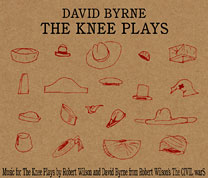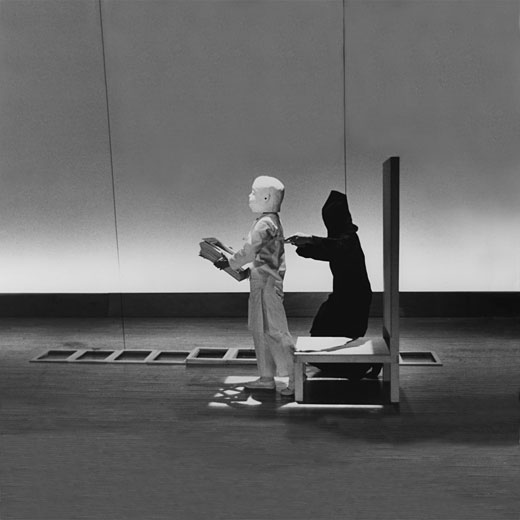THE ALBUM

- ESSAY
- TRACKS, LYRICS, & AUDIO
- CURRENT REVIEWS
- LIVE DATES (COMING SOON)
- CREDITS
- BUY CD (AMAZON.com)
- DOWNLOAD (COMING SOON)
WHAT’S A KNEE PLAY
Some of these texts were goofy but plausible little stories, some were lists, and some were instructions. I’d remembered JG Ballard saying once that lists, ads, codes, and instruction manuals are the invisible literature of today. I became the de facto reader of these texts in the initial performances, although Matthew Buckingham, now a well-respected artist and filmmaker, took my place when the piece toured.
Later, I recorded the pieces in L.A., with some of the best R&B and session musicians around, thanks to Gary Goetzman and some others who helped with the contracting and coördinating. The sessions were pretty exciting, though even these musicians had some problems with the syncopations for “In the Future.” Later, when the piece toured—as I’d hoped it would—the existing brass band Les Misérables (led by Frank London) took over and made it their own.
But what happened to the CIVIL warS? Oh, that. That’s a book unto itself. The Japan Section got only as far as the middle of one invited rehearsal when the “curtain came down.” The Butoh dancers, almost naked and cross-eyed, contrary to stage directions, started flapping their white makeup all over the Noh dancers’ lion wigs and extremely pricey brocade costumes. The Butoh leader started screaming in English, “We need light. We have Tofu face!” That production was never seen again.
According to some, L.A. pulled its funding at the last minute, funding which was to cover not the creation of the sections but the shipping of the sets and paraphernalia to L.A. and the restaging at the Shrine. I, for one, was not surprised. Things may have changed by now, but back then L.A. had a weak philanthropic arts community for contemporary work, and the public there was also not accustomed to productions like this. That said, I saw some large-scale international acts as part of the Olympic Arts Festival, so some groups were getting support. It was all a big scandal and Bob was heartbroken even if doing something of that scale in L.A. at that time did seem like a kind of quixotic quest. However, I remembered that he and Philip Glass had done Einstein at the Met, despite a lot of naysayers, so you never know. I think they had to rent that hall themselves.

Photo: JoAnn Verburg
This recording of the Knee Plays originally came out through ECM, the label known for innovative jazz and contemporary classical music with a lot of reverb. ECM recordings were being distributed by Warner at the time, which also distributed Talking Heads, and I thought the ECM audience and marketing sense might fit this project. I like a lot of what they do, so the original LP sleeve was designed to look like an ECM record. In retrospect, this wasn’t the smartest idea I’ve ever had.
It’s wonderful to see this project available again. I performed this material not so long ago at a Katrina benefit, and at Zankel Hall with Frank London and his current crew—and I don’t know about me, but they’re better than ever.
DB
NYC 2007
